Mooloolaba Coast Guard on Queensland’s Sunshine Coast believes it now has the best rescue vessel of its type in Australia.
Powered by twin 8.3-litre Cummins QSC engines, each rated at 500 hp, the new 14-metre Rhondda Rescue went into service in late 2012 and has a sprint speed of 27 knots.
Capable of operating in cyclonic weather, Rhondda Rescue cost the Mooloolaba branch of the Australian Volunteer Coast Guard in excess of $1 million.
“It was built without compromise,” says Rod Ashlin, senior Mooloolaba Coast Guard skipper who was project manager for the new vessel.
The Coastguard formed a committee in 2010 to begin the planning process for the rugged all-weather Rhondda Rescue. “We started with a clean sheet of paper in designing the vessel,” says Ashlin.
He points out the Coast Guard had a clear idea of the features it wanted and selected Western Australian firm Mark Ellis as the designer. “Mark Ellis has a well proven hull which was the key starting point for us,” he says.
The aluminium vessel was built by Brisbane’s Aluminium Boats Australia which “exceeded the spec without cost to the Coast Guard”, Ashlin points out.
“We researched the diesel engine options extensively before selecting the Cummins QSC,” he says.
“We spoke to many users of marine diesel engines and the consensus in the industry was that Cummins would be the best choice because it was a proven brand with proven back-up support.”
For good operational range, the vessel is equipped with two 1000-litre diesel tanks and also carries 600 litres in the keel for added stability.
Rhondda Rescue’s top speed of 27 knots meets the Australian Volunteer Coastguard’s requirement for a 25-knot capability.
Other features of the vessel include a raised pilot house for excellent visibility, and a small flybridge (behind the pilot house) with two ‘wing’ stations for close quarter manoeuvring and providing a commanding view of the working deck. A complete walk-around deck allows for safe crew passage and deck work.
Low noise and vibration mean there is only a muted throb from the Cummins diesels, a huge bonus for the rescue crews.
Crew amenities include a galley-mess room along with a two-berth cabin and toilet below the raised pilot house.
Mooloolaba Coast Guard typically responds to around 120 calls for assistance in a year. Rhondda Rescue is backed up by two smaller vessels.
The Mooloolaba operation has 140 volunteer members and costs around $150,000 a year to run.
“Most of the funding for Rhondda Rescue – around 80 per cent – was raised through raffle tickets and sausage sizzles while the rest of the money came from government and business grants,” Rod Ashlin points out.










